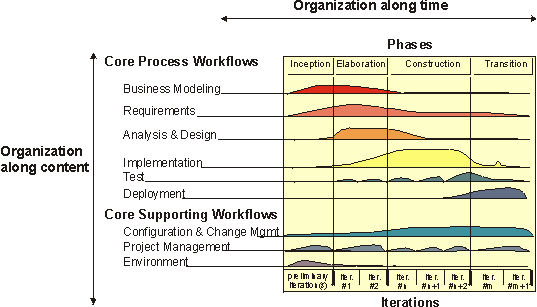The Rational Unified Process is a process that was developed
by Rational Software. They define it and sell it as a
product that integrates with other tools that they sell, but
the process can be used separately from the tool.
The key practices of RUP are:
- Develop software iteratively.
- Systematically elicit, organize, and manage changing requirements.
- Use component-based architecture.
- Visually model software using UML.
- Continuously verify software quality.
- Control changes to software.
There are 9 models
- Business
- Domain
- Use Case
- Analysis
- Design
- Process
- Deployment
- Implementation
- Test
There are 9 process workflows
- Business modeling
- Requirements
- Analysis and Design
- Implementation
- Test
- Deployment
- Configuration Management
- Project Management
- Environment
There are 4 phases to RUP:
-
Inception - project start. In this phase, the business
and requirements risks are evaluated, the business case
is defined, scope is defined, a candidate architecture
is created (maybe with a prototype) and the project
environment is prepared.
-
Elaboration - define the architecture and provide a
stable basis for Construction. Refine the vision,
create and basiline the iteration plans for
Construction. Create the Software Architecture Diagram.
-
Construction - completes development of the system.
Each iteration manages resources and controls the
process, develops and tests components, and assesses
the iteration (to refine future estimates).
-
Transition - includes testing, finalizing support
material, fine tuning, and delivery. Usually comes with
a Deployment Plan, Release Notes, and Training Materials
and Documentation.
The last three phases may contain multiple iterations.
Certain documents are maintained throughout the project:
-
Risk List - risks listed with mitigation
strategies
-
Project Plan
-
Various UML documents - as needed
-
Software Architecture Diagram (SAD)










